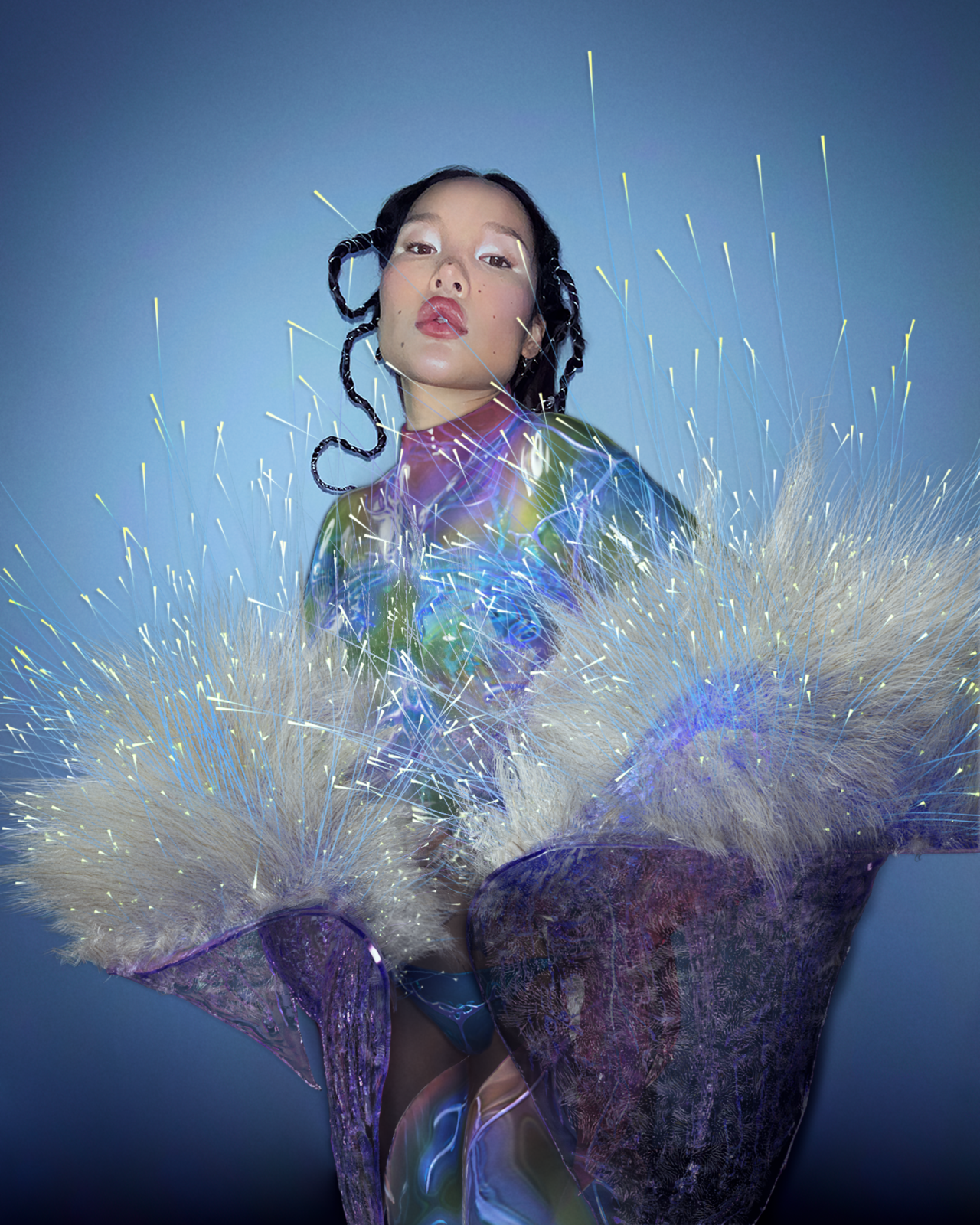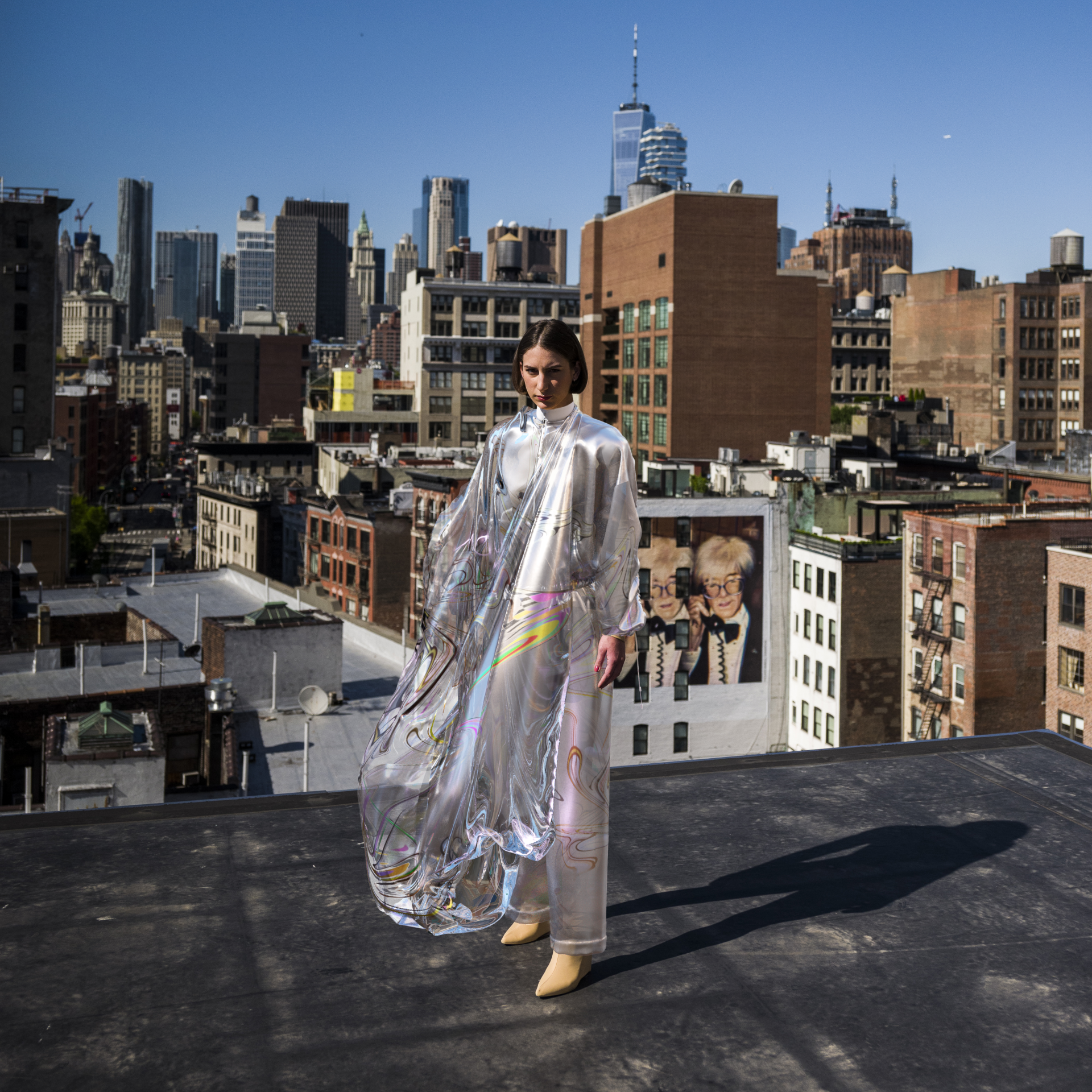Let’s talk Screenwear – Exploring Digital Fashion at Design Museum Den Bosch with its curator!

Auroboros, Atokirina coat and Mandrake bodysuite, 2021
With the potential to be a more sustainable, accessible and democratic alternative to the long-established physical practices, digital fashion still remains a mystery for many. Luckily, Screenwear — Exploring Digital Fashion, now showing at Design Museum Den Bosch, is here to answer all of your burning questions. Of course, the fundamental logistical inquiries regarding how to purchase and wear digital fashion are tackled, but the exhibition also gently steers the viewer towards more existential ones, as the lines between the physical and the digital are erased. The immersive experience teleports you to a digital realm where anything is possible, as it is fully dedicated to the most exciting talent at the forefront of modern fashion and the worlds they create. We caught up with the curator, Anne-Karlijn van Kesteren, of Screenwear, to talk about the looming metaverse and how exhibitions like this can make us more aware (and curious) citizens of the modern world.
Before diving into the depths of digital fashion, let’s begin with your role at the Design Museum Den Bosch?
My role is as a curator here. I was asked to do this exhibition last year, and I’ve also worked on a number of presentations for the museum. But, my main project is the Screenwear exhibition.
Maybe you could tell me a bit about what your goals for this project are…
It’s a new field to discover – we wanted to see if we could catch all the developments that are happening right now. We wanted to present it to the visitor in a way they could understand (because it is very new for a lot of people). It was an experiment to highlight the field and connect others with our view about the future. Essentially, to see how design develops, especially in a post-human way. But this is only one of the subjects we try to tackle, and it wasn’t easy to do. It’s such a new field, that every day there is something happening. The result is very nice though – we get a lot of positive reactions. A lot of young people, of course, but also older people who want to understand what’s happening.
Digital fashion is inherently geared toward a younger audience. What was your anticipated reaction between the generations? Have you witnessed this already?
The younger ones recognise a lot of the themes immediately. All of the developments entering the industry right now are brought by young designers, not big fashion houses. Older people are more curious – they take a lot of time to read the texts and have a closer look. Younger generations are also more involved in the interactive aspects of our exhibition. They also talk to each other about what they see and have these discussions. Every group is very curious.

The Fabricant, Iridescence Dress, 2019
This communication must be great!
Once, I was busy with something and there was a woman who’d been in the exhibition for over an hour. She came up to me and said ‘I now understand the world of my children and I’m going to come back with them, so they could tell me how it is reflected in their world.’ It was a big compliment for us. The mind is opened. It’s not like everyone understands everything, it’s a difficult subject. But it’s still very nice to look at – the works are just fascinating. The whole exhibition is an immersive experience, the screens are placed at every angle you can imagine. The idea behind is that it’s coming from everywhere in your life. All the cables are visible – you can see everything. Why should we deny it?
It’s like you’re on (or in) the screen itself.
You’re in a world that absorbs you, and technology is coming from everywhere. We have this big pavilion, in which you stand in the middle and there are mirrors all around – so it’s also about your reflection and how you fit into the narrative. And also – how you can wear it! It’s always the first question people ask ‘it’s digital fashion, how can I wear it?’ The way the exhibition is built also introduces the history – the segment called ‘History of the Future’ – where we talk about the innovations of the early 80s and the last few years that have been explosive.
I love that – History of the Future.
It’s the idea that you’re looking into a future, but it also comes from somewhere. You need to mention the metaverse, the video games, and the pandemic. Social media, Snapchat filters, and even Zoom filters. It all relates to each other. The future comes towards us very fast.
There is a line in the exhibition description that relates to this so much – ‘digital fashion is no longer science fiction.’ People see digital fashion as something unattainable but in reality, it’s already around us all the time.
Exactly. It’s already here, but people still think it’s in the future. I’ve talked to a lot of people in the fashion business, who already wear, say, digital earrings.
In many ways, digital fashion democratises the hierarchies and traditions of the fashion landscape, however, there is still a long way to go!
It’s not a utopia yet. You still have to work with software that is available. If you’re comparing digital fashion to physical fashion, in physical fashion you have enough materials, fabrics, patterns etc to create what you want. In digital fashion, there aren’t that many resources yet. We need to work towards a bigger set of tools and materials to push the boundaries of what digital fashion can do. For example, at Studio PMS, they’re digitalising historical silhouettes by looking at embroidery and historical sets and making them available. The sky is the limit, but we still have a limit. Younger generations are working together and are building up this whole new world.
It’s also about new ways of archiving fashion.
Absolutely.
On a wider global level, how do you hope this exhibition contributes to the ongoing dialogue surrounding digital fashion?
It’s already speaking to the community, and I hope to give it a push towards a bigger audience. We’re working on getting the exhibition to travel. I think we’re the first museum to dedicate a whole exhibition to digital fashion. It’s the first time the field gets highlighted from a design point of view, not just an introduction. But, it’s really exciting to work with all of this technology – tomorrow everything can be different.

The Diigitals, Shudu Gram, 2017
Images courtesy of Design Museum Den Bosch
Screenwear — Exploring Digital Fashion on display until the 23rd of February
Words by Grace Powell
Notifications